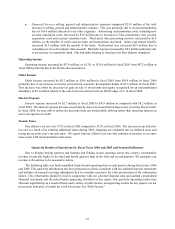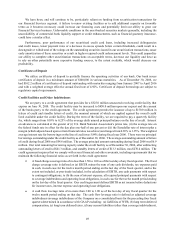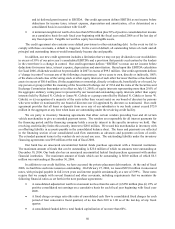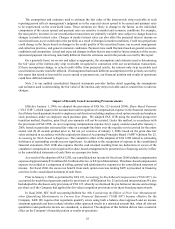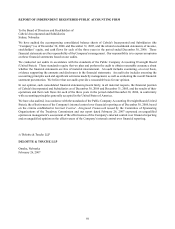Cabela's 2006 Annual Report Download - page 53
Download and view the complete annual report
Please find page 53 of the 2006 Cabela's annual report below. You can navigate through the pages in the report by either clicking on the pages listed below, or by using the keyword search tool below to find specific information within the annual report.49
We have been, and will continue to be, particularly reliant on funding from securitization transactions for
our Financial Services segment. A failure to renew existing facilities or to add additional capacity on favorable
terms as it becomes necessary could increase our financing costs and potentially limit our ability to grow our
Financial Services business. Unfavorable conditions in the asset-backed securities markets generally, including the
unavailability of commercial bank liquidity support or credit enhancements, such as financial guaranty insurance,
could have a similar effect.
Furthermore, poor performance of our securitized credit card loans, including increased delinquencies
and credit losses, lower payment rates or a decrease in excess spreads below certain thresholds, could result in a
downgrade or withdrawal of the ratings on the outstanding securities issued in our securitization transactions, cause
early amortization of these securities or result in higher required credit enhancement levels. This could jeopardize
our ability to complete other securitization transactions on acceptable terms, decrease our liquidity and force us
to rely on other potentially more expensive funding sources, to the extent available, which would decrease our
profitability.
Certificates of Deposit
We utilize certificates of deposit to partially finance the operating activities of our bank. Our bank issues
certificates of deposit in a minimum amount of $100,000 in various maturities. As of December 30, 2006, we
had $102.2 million of certificates of deposit outstanding with maturities ranging from January 2007 to April 2016
and with a weighted average effective annual fixed rate of 4.92%. Certificate of deposit borrowings are subject to
regulatory capital requirements.
Credit Facilities and Other Indebtedness
We are party to a credit agreement that provides for a $325.0 million unsecured revolving credit facility that
expires on June 30, 2010. The credit facility may be increased to $450.0 million upon our request and the consent
of the banks party to the credit agreement. The credit agreement permits the issuance of up to $150.0 million in
letters of credit and standby letters of credit, the nominal amount of which are applied against the overall credit
limit available under the credit facility. During the term of the facility, we are required to pay a quarterly facility
fee, which ranges from 0.10% to 0.25% of the average daily unused principal balance on the line of credit. Interest
on advances is calculated at the greater of (i) U.S. Bank National Association’s prime rate, (ii) the average rate on
the federal funds rate in effect for the day plus one-half of one percent or (iii) the Eurodollar rate of interest plus a
margin (which adjusts based upon certain financial ratios we achieve) and ranges from 0.65% to 1.35%. The weighted
average interest rate for borrowings on the line of credit was 5.84% during fiscal year 2006. There were no principal
borrowings outstanding under the credit facility as of December 30, 2006. The average outstanding amount of letters
of credit during fiscal 2006 was $54.6 million. The average principal amount outstanding during fiscal 2006 was $6.9
million. Our total remaining borrowing capacity under the credit facility as of December 30, 2006, after subtracting
outstanding letters of credit of $41.3 million, and standby letters of credit of $13.3 million, was $270.4 million. The
credit agreement requires that we comply with several financial and other covenants, including requirements that we
maintain the following financial ratios as set forth in the credit agreement:
• A fixed charge coverage ratio of no less than 1.50 to 1.00 as of the last day of any fiscal quarter. The fixed
charge coverage ratio is defined as (a) EBITR minus the sum of any cash dividends, tax expenses paid
in cash, in each case for the twelve month period ending on the last day of the fiscal quarter, and to the
extent not included, or previously included, in the calculation of EBITR, any cash payments with respect
to contingent obligations, to (b) the sum of interest expense, all required principal payments with respect
to coverage indebtedness and operating lease obligations, in each case for the twelve month period ending
on the last day of the fiscal quarter. Our credit agreement defines EBITR as net income before deductions
for income taxes, interest expense and operating lease obligations.
• A cash flow leverage ratio of no more than 3.00 to 1.00 as of the last day of any fiscal quarter for the
twelve month period ending on that day. The cash flow leverage ratio is defined as adjusted coverage
indebtedness (average indebtedness of the Company on a consolidated basis for the preceding four fiscal
quarters determined in accordance with GAAP excluding: (a) liabilities of WFB, (b) long term deferred
compensation, (c) long term deferred taxes, (d) any current liabilities (other than coverage indebtedness),




